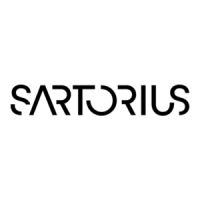Do you have a question about the Sartorius BP 410 S and is the answer not in the manual?
Guidelines for selecting a suitable environment for balance setup, considering drafts, heat, and humidity.
Procedure for connecting the balance unit to its external electronics box via cable.
Steps for assembling the weighing chamber with an analytical draft shield.
Steps for assembling the weighing chamber with a round glass draft shield.
Ensuring optimal accuracy by allowing the balance sufficient warmup time after power connection or outage.
How to turn the balance display on and off, and enter standby mode using the power key.
The automatic electronic self-test performed by the balance upon startup to confirm readiness for operation.
Procedure for performing internal calibration using the balance's built-in calibration weight.
Instructions for performing external calibration using external calibration weights.
How to access specific functions by unlocking the menu access switch on verified balances.
Guidelines for professional servicing, cleaning, and safety inspection of the balance.
Procedures for inspecting the balance and AC adapter for safe operation and when to seek service.
How to navigate and modify balance settings by entering specific menu codes using the keys.
Step-by-step instructions for accessing and confirming menu settings within the balance's operating menu.
How to adjust balance settings to match different ambient environmental conditions for optimal performance.
Selecting between standard weighing and manual filling modes to optimize weighing speed and stability.
Configuring the stability symbol display to indicate weight variations within a selected range.
Setting parameters for data output, including print-on-request and auto-print modes.
Configuring data output to occur automatically at specified intervals, such as every 1 or 2 display updates.
Defining and managing menu access switch functions for standard and verified balances.
A practical example demonstrating how to record tare, net, and gross weights using the Tare Memory function.
Setting display parameters for percentage readouts, including the number of decimal places.
How to change the reference sample quantity (pcs) for accurate piece counting.
Selecting between manual or automatic start modes for the animal weighing and averaging program.
Adjusting the number of subweighing operations used for averaging in animal weighing applications.
Connecting devices for generating ISO/GLP-compliant printouts or records from the balance.
Overview of the balance's built-in interface port and its capabilities for connecting to external devices.
Notes on connecting peripheral devices, ensuring proper electrical connections and potential interference mitigation.
Details on the structure and character requirements for sending control commands to the balance.
Control commands to adjust the balance's response to different ambient conditions (very stable to very unstable).
Explanation of handshake parameters (software and hardware) for ensuring reliable data communication.
Activating data output by sending a software command or pressing the print key.
Configuring automatic data output at defined intervals or upon balance startup, with or without stability parameter.
Technical specifications for the Sartorius Basicplus series balances, covering weighing range, readability, and environmental conditions.
Explanation of the CE marking and its significance regarding technical harmonization and standardization.
Details on the CE marking affixed to equipment, indicating compliance with relevant directives like EMC.
Details of the 'New Installation' service package, including initial verification and optimal working setup.
Information on the validity and requirements for subsequent verifications of weighing instruments in European countries.











